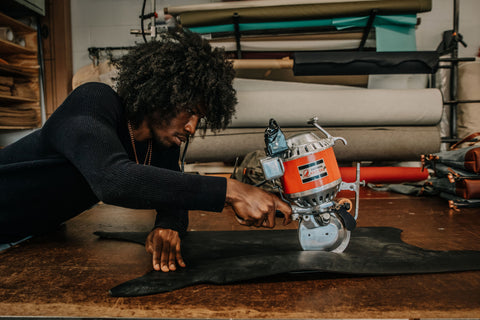Once all materials have been sourced, rolls of canvas, leather, and individual pieces of hardware are shipped directly to our shop. Upon receiving them, we organize each material into placeholders by item type and proximity to the location they’re most used. Leather rolls are stored on racks in between leather cutting machines. Canvas rolls are stored on wall racks located above the cutting table and next to ironing. Brass and copper hardware are categorized in sectioned bins, placed at our standing work table for easy accessibility; it is here where all bags are fastened and finished.

We receive our leather directly in a finished vegetable tanned form, rolled in its original hide shape. Wrapped carefully in brown paper to prevent any scratches or discoloration, we store each roll by color and style on a stacked flat shelf. When needed, we remove the roll and carry it to our cutting table, located adjacent to the storage. Using a straight-edge we score the desired lines and follow it with a hand-held fabric saw, creating a clean cut. Once in easy-to-handle sections, it is then carried over to our 25-ton press we call the “clicker”. Using custom steel dies (templates) created for each of our bag styles and straps, the leather is pressed and the shape is cut. If necessary, the leather will make an additional run through a skiver machine which thins the leather for easier folding and sewing. The straps are then taken to our hardware table awaiting buckles and hardware attachment. The leather bases and forms are stacked and taken to our seamstress sewing tables to begin the makings of a bag.

Our waxed canvas is delivered in rolls, some large and some small, depending on it being a reoccurring order or one-time limited-edition. Each roll is stored on wall mounted racks that are located directly above our cutting table. When cutting, we place the canvas on a dowel for easy unrolling. It is then measured, scored, and cut with the hand-held fabric saw and transferred to the seamstress sewing tables.

Each piece of hardware comes in its true and original form; all requiring sewing attachment, hammering, and machine pressing to become secured to the bag. Each zipper is prepped with a sewn canvas surround and a hand cut leather pull that is secured with a hammered copper rivet. All D-rings, swivel snap clasps, straps, buckles, and handles are secured by a hand-hammered copper rivet and sometimes the additional leather cut washer. Every button clasp is placed to fit in a canvas hole with a foot-pedaled press machine. These brass and copper details make our bags truly shine, each obtaining a different patina and becoming more stunning with age.

Our spools of thread come in every color, as we hand select the best one suited for each standard and custom designed bag. Located on wall shelves bordering our seamstress tables, each spool truly adds a colorful element of decor to our shop.

Just as each piece of leather, canvas, hardware, and spool of thread has a designated space in our shop, they also have an intentional function and place in our design. The prep work required to build these bags is an incredibly thorough and rewarding process. Placed in bins and boxes within arms-reach, our makers now have all the tools and hand-curated material needed to create A North End Bag.


61 comments
cPlwkRfa
RAWSBIEwONxJsXdF
Every product that I have ever purchased follows this supply chain description. The meticulous quality of form and function is the true essence of each part of a this complete union of usable components. Keep up the greatness and let other settle of good enough.
I love every bit of this. I love how far you have come! And I love that you love to sew just like me!
⭕️❌mum
VzMpPYnKT